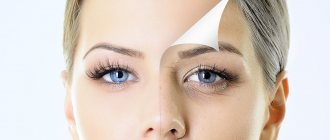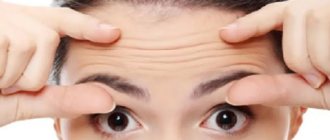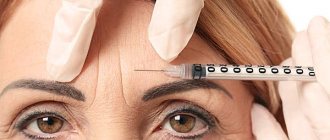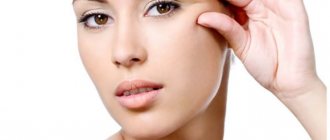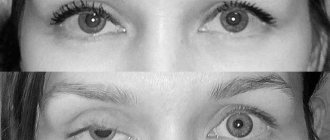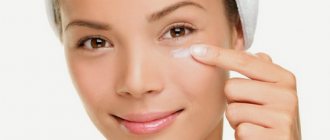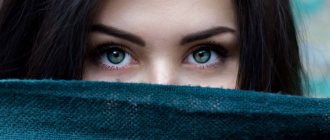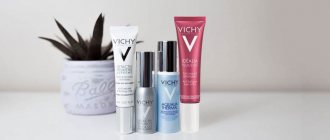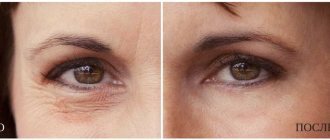The area around the eyes is the most susceptible to age-related changes due to thin skin and missing fat.
Wrinkles around the eyes, sagging skin, bags under the eyes are the main signs of beginning aging. Botulinum therapy can cope with some of these problems. In what cases will Botox injections be beneficial, and when will the injections not give the expected result? Due to the anatomical structure of the periorbital region - thin skin and actively functioning muscles - leads to the fact that at the age of 30, most people acquire the following imperfections in appearance:
- expression wrinkles in the corners of the eyes and under (and above) the eyebrows
- sagging skin of the upper eyelids
- hernias and dark circles under the eyes
- pigmentation
- blepharospasm, hemifascial spasm
- frequent small muscle twitches
However, botulinum toxin injections will not cure all of these problems. Indications for the use of Botox injections are very limited, since the effect of the toxin included in the drug is to relax muscle tissue by blocking nerve endings. The latter are not destroyed by injections, but only inhibit their functional activity. This principle of injection makes it possible to work with fine wrinkles caused by facial muscle contractions and other spastic contractions of muscle fibers when botulinum therapy is used for medical reasons. What do we end up with? Botox successfully eliminates:
- small expression wrinkles
- muscle twitching
- ptosis of the corner of the eye
- blepharospasm, hemifascial spasm
However, Botox injections are not used to tighten the skin in the eye area, eliminate drooping eyelids or hernias in the infraorbital area. To solve these problems, plastic surgery is intended - blepharoplasty. Botulinum toxin also does not fight edema; rather, it is necessary to treat blood vessels or kidneys. Laser treatments will help get rid of excessive skin pigmentation; Botox will not have any positive effect.
The effectiveness of Botox for wrinkles under the eyes
Small expression wrinkles under the eyes and in the corners of the periorbital zone, which are often popularly called “crow’s feet,” are an unpleasant phenomenon, since even on a young face they are associated with signs of aging. The cause of such aesthetic defects can be either the physiological characteristics of the patient’s facial muscles and skin, or overly active facial expressions and the habit of squinting. The reason for the formation of facial wrinkles around the eyes is the tension of the orbicularis periocular muscle, which is responsible for the condition of the skin in this area. It is this spasm that is eliminated by botulinum toxin preparations, in particular Botox.
The mechanism of action of Botox lies in the inhibitory activity of botulinum toxin type A, which is produced naturally by the bacterium Clostridium botulinum. Penetrating into the muscle, the toxin blocks the nerve innervation of the tissue, which leads to relaxation of the muscle structure. As a result of this effect, the skin that is attached to the muscle is also smoothed, which visually creates a noticeable rejuvenating effect.
When using Botox around the eyes, the orbicularis periocular muscle is relaxed, which is accompanied by the elimination of expression lines in this area. Today, Botox for the eyes is one of the most effective and safest options for getting rid of those same “crow’s feet” that haunt people who want to preserve beauty and youth for as long as possible.
Botox for crow's feet - a safe solution to the problem
Every year, imprints of experienced emotions appear on thin skin, including “crow’s feet.” Also the reason for this problem is:
- improper or insufficient facial care;
- decreased collagen production;
- too hot or too cold water temperature when washing;
- lack of quality sunglasses;
- using soap or shower gel to remove eye makeup and mascara;
- using facial skin care products instead of eye cream;
- lack of hydration;
- sleeping with cosmetics;
- vision problems.
Aesthetic defects can appear at rest or during tension or expression of emotions. Regardless of the cause of their occurrence, they require correction, according to reviews and photos of patients who have chosen beauty injections, the administration of botolutoxin is a relevant method of solving the problem.
Fighting expression lines under the eyes - dosages and places of Botox injection
Botox injections into the eye area require a highly qualified specialist to correctly determine the injection site. It is important to consider the following aspects of the procedure:
- Botox around the eyes - most often the doctor divides the total dose of the drug into 10 parts and makes multiple injections in the periorbital area, while avoiding the area under the eyebrows. Violation of this technique can lead to drooping of the upper eyelid;
- Botox under the eyes - often most of the injections are concentrated in the area under the eyes, at a distance of 1 centimeter from the outer edge of the eye;
- Botox in the corners of the eyes - injections into this area are done mainly to eliminate “crow's feet”, which are concentrated in this area.
The dosage of the drug is determined individually and depends on the severity of the defect and the gender of the patient. Men usually require more Botox injections than the fair sex. When asked how many units of Botox are needed for the eyes, experts recommend using 10 to 20 units.
When does Botox begin to work and what processes explain its effect?
Although some results from the procedure are noticeable after 3-4 days, botulinum toxin therapy may take several weeks to achieve its maximum effect. The delay is caused by the fact that after entering the body the drug is in the extracellular space, and it takes time to get into the nerve endings.
Once in nerve and muscle tissue, the toxin destroys the SNARE protein involved in conducting muscle impulses. SNARE proteins are constantly being produced, so the time to take effect depends on how quickly the toxin breaks down the protein. As a rule, this takes several days.
Once the SNARE is destroyed, the substance acetylcholine, which causes muscles to move, is blocked. Muscle fibers stop contracting, lines and wrinkles disappear, resulting in improved skin appearance. The treated area becomes smoother and fresher.
Effect of Botox
However, muscles can only be “slowed down” at certain motor points. The closer to the desired location the injection is made, the faster the drug will begin to act and the better the effect will be. Therefore, it is very important that the administration of botulinum toxin is carried out by an experienced doctor who is fluent in this technique.
Since everyone's facial structure is different, the specialist must know the anatomical features of the facial area in order to find the optimal injection points for each patient. Working according to a template leads to the fact that the drug is administered to everyone in the same way, which significantly worsens its effect.
Properly administered Botox by penetration-diffusion method spreads across neighboring muscles and engages the maximum number of muscle fibers. This explains its high efficiency.
In this case, increasing the dose is dangerous. Excessive medication will create unnecessary stress on the liver and lead to an undesirable effect in the form of a mask-like face, which will immediately indicate that Botox has been administered. That is why the result directly depends on the qualifications of the specialist who will select the optimal dosage.
A scientific study conducted by the National Institute of Neurological Disorders and Stroke (USA), the results of which were published in the journal Toxicon, indicates that botulinum toxin is a zinc-dependent compound. Therefore, in a patient whose body lacks zinc, the result will not appear longer, and the drug will work worse.
There is scientific evidence of a connection between the weak effect of Botox and a lack of enzymes. Therefore, in case of metabolic disorders, the effect of botulinum toxin may not appear longer than usual.
Features of the procedure
Before the specialist begins injecting the drug, the periorbital area is treated with a special cream containing an anesthetic. This makes the procedure completely painless for the patient. Next, using a thin needle, botulinum toxin is injected into the area around the eyes, which usually takes no more than 15 minutes.
After Botox, wrinkles under the eyes and crow's feet gradually smooth out over the course of a week, leaving smooth and visually youthful skin. The effect of the procedure usually lasts from 3 to 6 months, after which the drug is completely eliminated from the body, restoring normal motor activity of the eye muscles.
After the procedure, the patient can return to their normal lifestyle, following only a few post-procedure recommendations:
- you cannot take a horizontal position for the first few hours after the procedure;
- do not touch or massage the affected area;
- Do not paint your eyes for 24 hours after administration of the drug;
- you will have to stop taking alcohol, antibiotics and muscle relaxants for two weeks after Botox rejuvenation;
- Intense physical activity should be avoided for a month after injections.
Story
The history of creating a drug from a powerful poison has an unusual history. The first mention of the medical use of this toxin dates back to 1980, when physician F. Scott used it in ophthalmology to treat patients with strabismus. He used it to relieve spasm of muscle fibers. Subsequently, drugs based on poison began to be used in neurology. The high effectiveness of Botox led to the fact that already in 1989 the American committee recommended it for use in ophthalmology and neurology. After doctors administered the drug to eliminate neurological and ophthalmological symptoms, a peculiar side effect often occurred, consisting in a decrease in the severity of wrinkles around the eyes and in the forehead. In this regard, since the nineties of the last century, dermatologists began to use Botox to act on the ligaments of the subcutaneous muscle of the neck, eliminate eyebrow asymmetry and carry out complete facial rejuvenation.
Effects of Botox injections around the eyes
Complications and side effects after Botox injection into the periorbital zone develop rarely and most often manifest themselves in the form of swelling and hematomas, which quickly resolve without additional treatment. Even less commonly, allergic reactions and headaches may occur, which are a consequence of individual hypersensitivity to the drug and are detected in only 1% of the population.
One of the most unpleasant complications of eye Botox can be drooping of the upper eyelid, which is accompanied by the inability to fully open the eye. This effect is leveled out along with the removal of the drug from the body, after which the motor activity of the eyelid is restored.
Contraindications and possible complications
Like any cosmetic procedure, botulinum therapy has its limitations. Botox injections will not be performed on patients with severe diseases of internal organs or local inflammatory processes. The procedure is not performed on pregnant and lactating women and minors.
As for possible complications, the cause of their occurrence is medical error. In rare cases, the individual characteristics of the patient’s body. the most common negative consequences are subcutaneous bleeding, significant swelling, sagging eyelids, and a local allergic reaction. Usually these complications go away on their own within a month.
How much does Botox around the eyes cost?
In the modern cosmetology department of the Neomed clinic, the cost of the Botox rejuvenation procedure is 300 rubles per unit of the drug. Since the dose required for correction is determined individually, the cost of the procedure will also vary in each specific case. In addition to affordable prices and a wide range of Botox rejuvenation services, our clinic offers the services of highly qualified specialists and the use of high-quality botulinum toxin preparations.
Find out the cost of the Botox procedure
Mechanism of action
When treating the diseases listed above, both surgical and therapeutic approaches are used. At the same time, the cause of hypertonicity of muscle fibers is not directly affected.
By injecting botulinum toxin, it targets the muscles. Thin needles are used for insertion. The duration of the blockade of nerve impulse transmission to muscle cells reaches six months, after which the poison is destroyed. That is, during this time the muscles are in a relaxed state.
Due to this, Botox helps patients cope with strabismus, blepharospasm, facial wrinkles around the eyes, in the bridge of the nose and forehead.
As a result, unwanted hypertension is eliminated. To maintain the effect, it is enough to repeat the procedure 2-3 times a year. This allows you to eliminate all the symptoms of these diseases. Despite the fact that this drug is based on poison, its use in ophthalmic practice is absolutely safe. This is due to the fact that only a small amount of the substance is injected directly into the problem area. The action of the toxin is local and selective, which completely distinguishes it from other ophthalmic agents.
But there is one thing: the duration of action does not exceed six months, after which it is necessary to repeat the procedure. Unfortunately, the effectiveness of Botox decreases over time.
International units are used to measure the potency of Botox. Depending on the dose, the speed of onset of the effect varies. In small doses, the drug does not begin to act immediately, but after 1-2 weeks. If the doses are average, the effect becomes noticeable after 24-72 hours, with maximum effectiveness observed after two weeks. When using high doses of Botox, in some cases a clinical effect can be observed after 6 hours. For example, for blepharospasm, 20 units of the drug are most often used. If we compare this dosage with the treatment of neurological pathology, when the dose is 5-10 times higher, it becomes clear that there is no talk of a toxic effect of the drug on the body.
Technique and features
To administer Botox, a thin needle is used, which is placed only at special points in the forehead, eyelids, bridge of the nose, and lateral corners of the eyes.
Before the procedure, you need to conduct a clinical examination (during muscle rest and during facial activity). It is important to pay attention to the effect of raising the eyebrows, asymmetry, as this helps to identify an anomaly.
It is important to carefully collect anamnesis, focusing on the presence of neuropathy, including diabetic or alcoholic.
When administering Botox, it is important to maintain sterile conditions. When treated with this technique, a change in the shape of the eyelids (due to paralysis) and slight drooping of the eyebrows are possible. It is important to note that blepharoplasty after Botox injection has its own characteristics and should take these factors into account. When using the toxin in ophthalmology, many patients note the elimination of tension headaches.

